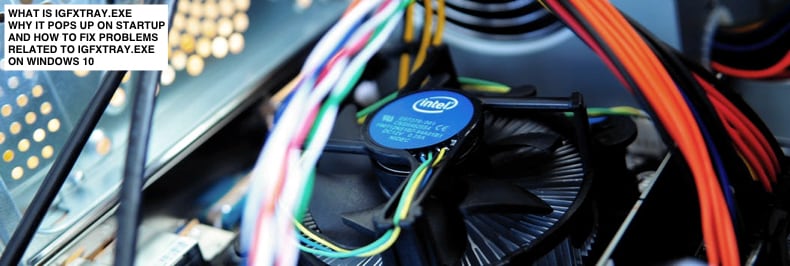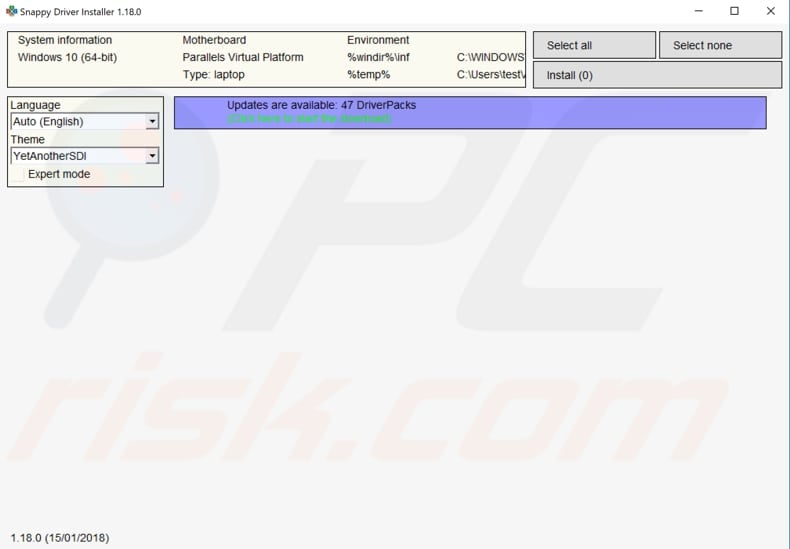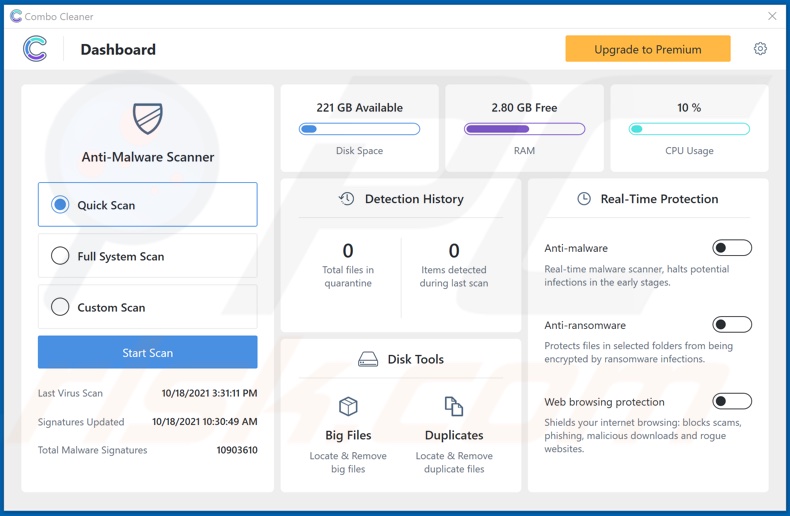What Is Igfxtray.exe and What Does it Do?
Get Free Scanner and check your computer for errors
Fix It NowTo fix found issues, you have to purchase the full version of Combo Cleaner. Free trial available. Combo Cleaner is owned and operated by Rcs Lt, the parent company of PCRisk.com read more.
What Is Igfxtray.exe, Why It Pops up on Startup, and How to Fix Issues Related to This Process on Windows 10
Igfxtray.exe is a process, part of Intel Common User Interface, also known as Intel Graphics Accelerator. Many users are unaware of this process and the various errors and problems related to it. This article will show how to fix these problems.

The Igfxtray.exe is a legitimate Intel process of Intel and part of the software installed on the operating system. The igfxtray.exe is usually located in the C:\WIndows\System32 folder.
It is not a Windows system file but is signed by Microsoft. Since it is a non-system process, igfxtray.exe can be stopped. The process is not involved in running the operating system and does not use extensive CPU resources, so you should let the process run.
Despite this, it is possible to stop this process and remove it from the operating system. You can do this by uninstalling the entire Intel Common User Interface or Intel Ultra Mobile Media.
It is not malware, and this file is generally considered to be safe. Errors with this process can affect video quality and overall system performance. Possible causes of igfxtray.exe errors are conflicts with the file or installation profile, misuse of the file or respective directories, or even a malicious infection on the system.
The most common error messages appearing are: "File not found: Igfxtray.exe," "Cannot find file: Igfxtray.exe," and "Device not recognized, missing Igfxtray.exe file."
As mentioned before, this process/file is generally not harmful but can cause problems. For example, if the file is infected by malware/malicious software.
The igfxtray.exe filename might be used to infiltrate the system. We mentioned that this file is located in the C:\Windows\System32 folder (where it should reside), but if you notice a file named igfxtray.exe in another folder/directory, the computer might be infected.
Table of Contents:
- Introduction
- Update Your Drivers
- Update Your Windows
- Scan Your System for Viruses
- Uninstall Intel Common User Interface
- Run System File Checker
- Clean Temporary Files and Folders Using Disk Cleanup
- Repair Your Operating System Using DISM
- Restore Your System Using Restore Points
- Video Showing How to Fix Errors Related to Igfxtray.exe
Download Computer Malware Repair Tool
It is recommended to run a free scan with Combo Cleaner - a tool to detect viruses and malware on your device. You will need to purchase the full version to remove infections. Free trial available. Combo Cleaner is owned and operated by Rcs Lt, the parent company of PCRisk.com read more.
Update Your Drivers
If there is any new software installed on Windows or hardware connected to the computer, you might need to update the drivers for the operating system to run correctly. Issues with igfxtray.exe can be related to corrupt or outdated device drivers.
Finding the particular driver causing problems manually can be difficult and time-consuming. There is also the possibility of installing the wrong drivers while trying to update the current ones. Fortunately, there is third-party software such as Snappy Driver Installer.
Snappy Driver Installer (SDI) is a powerful free driver updater tool for Windows that can store its entire collection of drivers offline. You can download Snappy Driver Installer from here.

Update Your Windows
You might also want to update the current version of Windows. Checking for updates for the entire Windows operating system is usually a good idea and could help with problems with the igfxtray.exe process. To check for Windows Updates, type "check for updates" in Search and click the "Check for updates" result.

You should be automatically directed to the Windows Update section. Click "Check for updates". Windows will start checking for updates. If there are updates available, install them and check for updates again (just to ensure that you have the latest updates on your operating system).
After the updates are installed (if there were any to install), see if you still have issues with igfxtray.exe

Scan Your System For Viruses
One possible reason for problems with the igfxtray.exe process/file could be a malware infection (or infections) on your computer - the igfxtray.exe file becomes a component of the malicious software.
Perform a full system scan and see if it detects any malware on the system. You can use Windows Defender (a built-in antivirus program), which protects the computer against viruses, spyware, and other malicious software. Alternatively, use other third-party antivirus software.
To run a full system scan using Windows Defender, type "defender" in Search and click the "Windows Defender settings" result.

Click "Open Windows Defender Security Center" on the right pane.

In the Virus & threat protection window, click "Advanced scan".

Select "Full scan" and click "Scan now". This will start scanning your system for malware. If there are any viruses found, delete them and see if the problem is fixed.

We also recommend that you try out the third-party anti-malware software called Combo Cleaner. Combo Cleaner is an anti-malware software for Microsoft Windows and macOS that finds and removes malware. You can download Combo Cleaner by clicking this link.

Uninstall Intel Common User Interface
If your computer is not infected, and you still wish to remove igfxtray.exe from the Windows operating system, uninstall the Intel Common User Interface (the name of this package might vary) by typing "run" in Search and clicking the "Run" result.
This will open the Run dialog box. Type "appwiz.cpl" and press Enter on your keyboard - this will launch the "Programs and Features" window.

In the Programs and Features window, locate the Intel Common User Interface (or similar) and uninstall it by right-clicking on it and choosing "Uninstall" from the drop-down menu.

Run System File Checker
System File Checker (SFC) is a utility in Windows that allows users to scan for corrupted Windows system files and restore them. The "sfc scannow" option is one of several specific switches available with the SFC command, the Command Prompt command used to run System File Checker.
To run it, first open Command Prompt first by typing "command prompt" in Search, right-click on "Command Prompt", and then select "Run as administrator" from the drop-down menu to run Command Prompt with administrator privileges.
You must run an elevated Command Prompt to be able to perform an SFC scan.

You will be asked if you want to allow this app to make changes to your device. Select "Yes".

Type "sfc /scannow" in the Command Prompt window and press Enter on your keyboard to execute this command. System File Checker will start and take some time to complete the scan (about 15 minutes).
Wait for the scanning process to complete and restart your computer to see if you still have issues with igfxtray.exe

Clean Temporary Files And Folders Using Disk Cleanup
The simplest and quickest way to delete temporary files and folders from your Windows is to use Disk Cleanup. Disk Cleanup is used to reduce the number of unnecessary files on your drives, which can help your PC to run faster.
It can delete temporary files and system files, empty the Recycle Bin, and remove various other items that you might no longer need. These junk files might affect your computer's processing speed, causing apps to respond slowly and can even prevent them from launching.
These files can cause issues with igfxtray.exe. To run Disk Cleanup, type "disk cleanup" in Search and click the "Disk Cleanup" result.

Choose the files you want to delete (this tool also displays the amount of space you can free up by deleting certain files and folders) and click "Clean up system files".

Repair Your Operating System Using DISM
Deployment Image Servicing and Management (DISM) can repair and prepare Windows images, including the Windows Recovery Environment, Windows Setup, and Windows PE.
To run a DISM scan, open Command Prompt as administrator again. Type "command prompt" in Search and then right-click on the "Command Prompt", select "Run as administrator" from the drop-down menu to run Command Prompt with administrator privileges.
Type this command: "DISM /Online /Cleanup-Image /RestoreHealth". Press Enter on your keyboard to execute it. See if this solves the issues with igfxtray.exe

Restore Your System Using Restore Points
The System Restore tool creates restore points. A restore point is a collection of important system files stored by System Restore on a given date and time. System Restore reverts everything to a saved restore point, but first, you must have one recorded. If a restore point does not exist on your computer, System Restore has nothing to revert to.
To use this tool, you must have created restore points. With a created restore point, this feature will bring your system back to the previous working state, without affecting your files and data.
This solution is a last resort, but if you have any system restore points created before you started experiencing issues with igfxtray.exe, you might be able to fix the problem by performing a System Restore.
To restore your system, launch Run. To start it, press the Windows Key + R and type "rstrui.exe". In the Run dialog box, press Enter or click "OK".

In the System Restore window, click "Next".

If there are restore points created, you will see a list of them. Mark the "Show more restore points" checkbox. This should display more restore points. Select the restore point that suits you best (depending on the time created etc.) and click "Next".
Do not select a Restore Point at a time when the issues with the igfxtray.exe process were already present - you certainly do not want to revert to that state.

Confirm the restore point. Your computer will be restored to the state before the event detailed in the "Description" field. If you are happy with your choice, click "Finish" to begin the system restore process.

We hope this article helped you understand the igfxtray.exe process/file (where it comes from and if it might harm your computer) and solve any associated problems. If you have any other suggestions about solving issues related to taskeng.exe, please leave a comment in our comment section at the bottom.
Share:

Rimvydas Iliavicius
Researcher, author
Rimvydas is a researcher with over four years of experience in the cybersecurity industry. He attended Kaunas University of Technology and graduated with a Master's degree in Translation and Localization of Technical texts. His interests in computers and technology led him to become a versatile author in the IT industry. At PCrisk, he's responsible for writing in-depth how-to articles for Microsoft Windows.

▼ Show Discussion